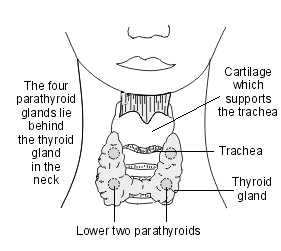What is a parathyroidectomy?
What are the parathyroid glands and what do they do?
Usually, you have four parathyroid glands. These are located behind the thyroid gland, two on each side, at the front of the neck. Each parathyroid gland is about the size of a pea, being 3-4 mm in size.
They are responsible for making a hormone (called parathyroid hormone, PTH) which is required for the control of calcium in the body.
So. What is a parathyroidectomy?
A parathyroidectomy is an operation that removes one or more of the 4 parathyroid glands. A parathyroidectomy involves a small incision in the front of the neck.
It used to be a common operation done on patients with ESRF on dialysis. In this situation it is usually done because the patient has high calcium and phosphate level in the blood.
It is now not often done as we have drugs like alfacalcidol and cinacalcet that can treat renal bone disease (that is due to overactive parathyroid glands).

The four parathyroid glands are located behind the thyroid gland in the neck
Why is a parathyroidectomy required?
Parathyroid gland problems requiring parathyroidectomy include:
- Hyperparathyroidism (overactive PTH glands). This is usually caused by ‘hyperplasia’ (overgrowth and overfunctioning) of one or more glands, producing too much PTH. This shows itself as a high blood calcium level. There are various types:
- Primary
- Secondary or tertiary. These are usually the problem if CKD is the cause of hyperparathyrodism
- Parathyroid nodules
- Parathyroid tumours – benign (adenoma) or malignant.
Note. Radiation therapy, nutritional deficiencies and the use of some medications such as lithium can also damage the parathyroid glands and affect their production of PTH.
What tests need to be done before the operation?
Blood tests help your doctor determine if there is a problem with your parathyroid glands that requires removal.
Blood tests include:
- Creatinine and GFR (kidney function)
- Calcium
- Phosphate
- Alkaline phosphatase (‘Alk Phos’)
- PTH.
The doctor may also request other tests:
- Ultrasound, nuclear medicine scan, computed tomography (CT) or magnetic resonance imaging (MRI) to visualise the parathyroid glands and surrounding area
- Bone density screening
- Examination of the vocal cords and their function using an instrument called a laryngoscope.
What does the surgery involve?
The operation is carried out under general anaesthetic, which means that you will be asleep.
Once you’re asleep, a horizontal incision (cut) is made in one of your skin creases in the neck and some or all of the parathyroid glands are removed. A surgical drain may be inserted to allow any blood to drain.
Your voice box will be monitored during the operation to avoid or minimise the damage to your voice. The incision is then glued or sutured (stitched).
The operation normally takes about 1 hour.
Who does the operation?
The operation is technically quite difficult, because the parathyroid glands are very small and can sit in variable positions. Therefore the operation is performed by a specialist surgeon with particular expertise.
What are the risks of parathyroidectomy?
- Persistent low blood calcium levels. Once the overactive parathyroid gland has been removed, the other glands may take a few days before returning to normal activity
Note. For these reasons your calcium level can drop too much and this can cause tingling in you lips and fingers. For this reason your calcium should be checked daily for at least 3 days after the operation. If a low calcium occurs, it can be treated with calcium supplements and vitamin D. These may be required in high dosage initially, sometimes via an intravenous drip in hospital - Hoarseness of voice. This usually settles over a few weeks, however, in a very small number of patients, this may become permanent. It is due t0 damage to the laryngeal nerve – this nerve supplies the vocal cords. The chance of the nerve being damaged is 1-2%
- Sore throat
- Bleeding and blood clots
- Adhesions or scar tissue requiring further surgery
- Injury to the oesophagus or trachea (windpipe)
- Failure of surgery to reduce calcium and PTH level. Sometimes the operation does not work (in 5% of patients). This may be because there are 5 parathyroid glands, or one is in an unusual place (even the upper chest), or because a gland in its normal position is missed. These problems can occur with the most careful and expert of surgeons. Further blood tests, scans and surgery are then required.
Care of your wound
When you are discharged from hospital you can expect to be given advice about care of your wound from the ward staff. The wound may be covered by a dressing and this can usually be removed after 48 hours unless you are told otherwise. You will usually be able to take a bath or shower 48 hours after your operation. Gently pat your wound dry rather than rub it.
Summary
We have described what is a parathyroidectomy. It is occasionally required in patients with CKD. We hope it has been helpful.
Other resources
What is parathyroid hormone (PTH)?
Functions of kidney: vitamin D activation
Parathyroidectomy: patient information
https://www.youtube.com/watch?v=oGV-r1JbGqQ
Last Reviewed on 13 May 2024
